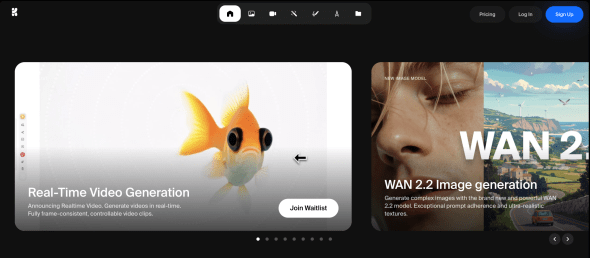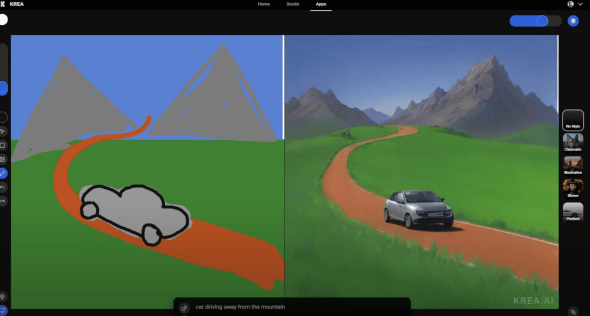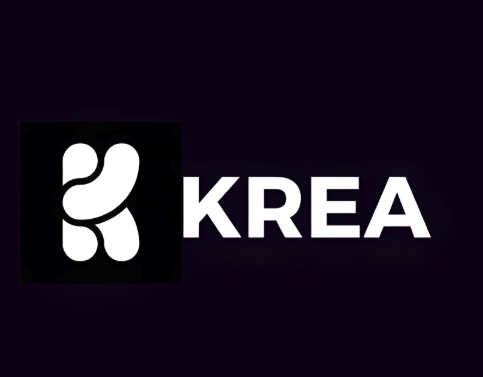Krea AI: Real-Time Creativity and AI Generation
Krea AI is a creative tool that provides a real-time image canvas and features for AI generation. Developed by Victor Perez and Diego Rodriguez, the platform started in 2022. Krea AI is used by graphic designers, marketers, and digital artists to produce animated visual content.
Krea AI’s main function is to connect its instant image creation capabilities with its video animation tools. This setup offers a different approach compared to traditional video production methods that often require more time and separate software. By integrating these functions, this tool assists in the quick production of short video clips and animations directly from static images.
Best Use Cases for Krea AI
- Social Media Marketers: For producing a high volume of content, the platform helps accelerate the workflow. A marketer can design a product image on the real-time canvas and then use the AI generation to animate it for a social media post. This method is effective for creating short video ads, animated announcements, or looping visuals that can improve audience attention.
- Animators and Indie Game Developers: The AI agent functions as a useful tool for rapid motion prototyping. An animator can use the Motion Transfer feature to apply a reference video’s movement to a new character design. This allows for quick evaluation of how a character looks in motion, which is useful for pre-visualization and making simple character animations without complex rigging.
- Digital Artists and NFT Creators: Artists can add motion to their static digital artwork. Krea AI allows them to take a still portrait and make the character blink or breathe, or to create a landscape where clouds move. This capability is useful for producing more dynamic art pieces for digital galleries or NFT collections.
- Educators and Corporate Trainers: Krea AI helps in the creation of instructional content. A trainer can generate an avatar and use the Video Lipsync tool to have it narrate a presentation. This provides a more visual way to present information compared to a standard voice-over-slideshow format, which can make training materials more effective.
Animate Still Images Directly: Krea AI's core video features, Motion Transfer and Video Lipsync, allow users to animate static images without needing prior animation experience.
Integrated Image-to-Video Process: The platform connects its image creation canvas with its video tools, allowing for a continuous workflow from concept to animated clip.
High Accessibility: The direct interface reduces the learning time often associated with animation software, making video creation available to a wider audience.
Fast Motion Prototyping: The tool allows for quick tests of animation ideas that would take significantly longer to mock up using conventional software.
Useful Creative Suite: Beyond video, it offers functions for enhancing and upscaling both the source images and the final video files.
Functional Free Tier: The free plan includes enough daily credits to test the main video and image functionalities before committing to a paid plan.
Video Generation is Not Instantaneous: While the name suggests "real-time generation," the process requires rendering. Video creation is queued and can take several minutes, which interrupts an iterative workflow.
Variable Video Output Quality: The AI can have difficulty maintaining visual consistency in a video, sometimes producing clips with distorted or illogical motion artifacts.
Noticeable Rendering Times: The processing time for AI video generation can be considerable, particularly for higher-resolution outputs, which can slow down production.
Few Fine-Tuning Controls: Krea AI does not have a timeline, keyframes, or other detailed controls found in dedicated video editing programs, offering little ability to edit a clip after it's generated.
-
AI Video Generation: Creates short video clips from text prompts or a source image.
-
Motion Transfer: Applies the movement from a source video file to a static target image to animate it.
-
Video Lipsync: Animates a character’s mouth in an image to match the speech in an uploaded audio file.
-
Real-Time Generation (for Images): An interactive canvas that acts as the starting point for creating the visual assets for animation.
-
Enhancer & Upscaler: A tool to increase the resolution and detail of both images and final video files.
-
AI Training: Allows users to build a custom AI model based on their own images to maintain a specific style in their video assets.
-
Image Generation: Creates high-resolution still images from descriptive text prompts.
-
Patterns & Logo Illustration: Tools for creating supporting visual graphics for video projects.
 Krea AI Homepage
Krea AI Homepage
 Real Time Generation Krea AI
Real Time Generation Krea AI
Frequently Asked Questions
-
Does Krea AI offer real-time generation?
The image generation canvas in Krea AI is real-time. -
Can I animate my own images with Krea AI?
Yes, you can upload your own images to use with the platform’s video tools like Motion Transfer and Lipsync. -
What is the maximum length for videos?
Krea AI is built for creating short video clips, generally lasting only a few seconds. It is not designed for producing long-form video. -
Do I need animation experience to use the video tools?
No, the video features in Krea AI are designed to be direct and do not require formal animation or video editing skills. -
How does Krea AI compare to Runway for video?
Krea AI is effective at quickly animating still images within an integrated workflow. Runway is a more specialized video-first platform with a wider array of AI generation and editing functions.
Tech Pilot’s Verdict on Krea AI
I tested Krea AI to evaluate its video creation process. My objective was to create a short, animated clip for a fictional brand, starting from a blank slate. I focused on the workflow between the real-time image canvas and the AI video generation tools to see how well they worked together.
My project was an ad for a coffee brand. I began on the Real-Time Generation canvas. My prompt was “astronaut drinking coffee in a colorful nebula,” and I drew a basic human shape with a cup. The canvas updated my drawing into a detailed image instantly. Adjusting the scene by adding prompts like “swirling stars” was fluid. This part of the tool is highly responsive and serves as a strong foundation for any video project.
After finalizing the astronaut image, I moved it to the animation tools. I used the “Video Generation” feature with the prompt “subtle steam rising from cup, stars twinkling slowly.” I submitted the job and waited. This is where the workflow is no longer real-time; the job entered a queue and took about three minutes to deliver the four-second clip. The result was good—the steam effect was convincing, but the astronaut’s arm moved unnaturally in one of the output options. It required a second attempt to get a clip without motion artifacts.
Next, I tested Motion Transfer. I recorded a short video of myself nodding and talking, then applied that movement to my astronaut image. The head movement transferred effectively, giving the character a sense of life. The mouth movement, however, was a generalized motion rather than a precise synchronization. For that specific task, the dedicated Lipsync tool would be required.
This tool provides a real-time image workflow that feeds into a separate, queued AI video generation process. The platform’s strength is the close integration of these two steps. Creating an animated character from an idea in under 10 minutes, including rendering waits, is a significant speed-up compared to traditional methods.
Top Alternatives to Krea AI
-
Runway: For work focused primarily on video, Runway is the leading option. It is a dedicated AI video platform with more developed features, including high-quality text-to-video, video-to-video styles, and specific editing tools like inpainting and motion tracking. Krea AI is better for quickly animating a single image, while Runway is built for generating and editing more complex video scenes.
-
Pika Labs: Pika is another strong competitor focused on AI video generation. It provides image-to-video and text-to-video functions similar to those of its peers and is often noted for its cinematic results. Its interface is direct, mainly operating through a prompt-based system. Pika is a solid choice for users who want a straightforward tool for generating short, artistic video clips.
-
Leonardo AI: While mainly an image generator, Leonardo has added animation features. Its advantage is the ability to create consistent characters through its custom model training, which can then be animated. If a project requires a character to appear the same across multiple animated clips, Leonardo’s image-first, consistency-focused process may be more suitable than Krea AI’s general-purpose tools.
Final Verdict
In summary, Krea AI is an effective tool for adding motion to static images. While its AI video generation is not instantaneous, the speed and directness of the image-to-animation process are valuable. It is a well-suited tool for marketers, artists, and creators who want to produce dynamic content without using complex animation software. For intensive video production, Runway is a better fit, but for fast and functional image-to-video creation, Krea AI performs very well.

